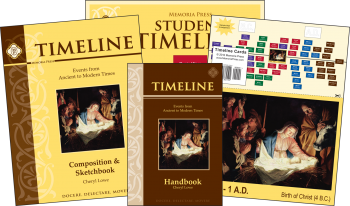Memoria Press’s Timeline set is designed to be used in conjunction with their history curriculum although it could work in other situations for those either pursuing a classical education or using the Famous Men series of books.
The format is rather different than other timelines that are popular among homeschoolers. An 85-page Timeline Handbook explains briefly how to use the set and provides lists of timeline events for each grade level for grades 3 through 6. After this, the bulk of the Handbook is a page on each of the key events highlighted by the timeline. For each event, we are given the date, key participants, key locations, and an event description.
There are three other items in the Memoria Press Timeline set. Timeline Cards are used to create a color-coded visual summary of key historical events that will be displayed on a wall. While most timeline sets use illustrations for events, this set includes only one illustration--the Nativity--on a large card that is mounted in the center of the timeline with “B.C.” and “A.D.” cards mounted to the left and right respectively. All other timeline events are represented by 60 smaller cards that show only dates and names of events. The smaller cards are color coded to indicate five different categories. The Handbook suggests mounting the Timeline on a grosgrain ribbon, but I suspect you might want to mount the cards in a more stable fashion.
Student Timeline Flashcards are the same size and colors as the smaller cards for the wall set, but these cards have names of events on one side and the dates on the reverse so they can be used for study and drill.
Students also have a Timeline Composition and Sketchbook. For each of the 60 events, this book has a two-page spread. On the left is a picture-frame box in which students are to create their own illustration for the event. On the right are blank lines for students to write in key participants, key locations, and event descriptions. Generally, students would write their own summary of the event rather than copy the description given in the Handbook, since some of those descriptions are quite lengthy.
You will need to purchase the set. Then if you have more than one student, each additional student will need his or her own Composition and Sketchbook. You might also want each student to have his or her own set of Student Timeline Flashcards.
The five categories for the cards are Bible, Greece, Rome, the Middle Ages, and American History. Obviously some of the categories overlap each other, and coverage of history is incomplete since this is used for only grades 3 through 6. Following Memoria Press’ system, just a few American History events are covered most years. Third grade focuses heavily on the Bible category, fourth grade on Rome, fifth grade on the Middle Ages, and sixth grade on Greece. Of course, you can change the order if you wish.
While many timelines include a predictable selection of key events, the Memoria Press Timeline is weighted so heavily toward the Greek and Roman time periods that it includes cards for many events that other timelines omit such as “Octavian becomes the first emperor” (or Rome) in 27 B.C. and “The Death of Pericles” in 429 B.C. In addition, the Timeline set clearly posits the Birth of Christ as the pivotal event in history while simultaneously dedicating an entire category to key biblical events. Consequently, the Memoria Press Timeline set will best suit those wanting to teach a Christian approach to history.









